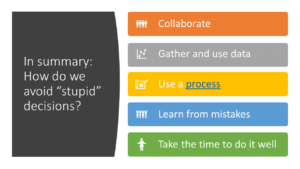
Turns out you CAN fix stupid – even better, avoid it in the first place!
“Good people make good decisions and bad people make bad decisions.” Do you agree with this statement? Probably not – I’m guessing we all have enough life experience to know that good people sometimes make bad decisions, and vice versa. Even with this understanding, when things go wrong, we often start attacking the people involved and questioning their motives, capabilities, or experience. Why do we assume the fault lies in the person? When decisions go awry, the fault almost always lies within in the process or approach by which the decision was made.
Author, educator, entrepreneur, Adam Robinson, reflects on and defines stupidity:

Of course, oftentimes information is only “conspicuously crucial” when you are looking at it after the fact (think O-rings on the shuttle or the MCAS system on Boeing’s 737 MAX jets.)
Where does decision-making “stupidity” stem from? It usually comes from one or more of the following:
- Using cherry-picked information – and ignoring conflicting information. Usually this is done to justify a desired outcome.
- Not seeking the information we need in the first place – or when we do, not being able to distinguish the relevant pieces of data from the irrelevant – it all looks potentially important.
- Failing to learn (i.e. glean information) from our mistakes and successes – our own and others’
- Allowing ourselves to be overly influenced by certain stakeholders while overlooking or not seeking the input of other stakeholders.
- Taking the path of least resistance and doing what’s easy vs doing what is right. There’s often more pressure to do something quickly than there is to do it well.
- Neglecting to involve others – this deprives us from having the additional information, perspective, thinking, and ideas that they might provide.
So how do we avoid “stupid”?
- Collaborate and involve the right people
- Gather and use accurate, relevant information and data
- Use a process so we are sure to cover our decision-making bases
- Keep learning from mistakes and successes and experience – our own and others
- Don’t be afraid when decision-making gets a little messy. Making tough, smart decisions is not necessarily easy. But when it’s important, doing it well is more important than doing it quickly.

For more tips on avoiding stupid mistakes in decision making, read: